Family (Alpha): ACRIDIDAE GRYLLACRIDIDAE GRYLLIDAE GRYLLOTALPIDAE RHAPHIDOPHORIDAE ROMALEIDAE TETRIGIDAE TETTIGONIIDAE TRIDACTYLIDAE
View Gryllidae Members:
Acheta domesticus Anurogryllus arboreus Gryllus unidentified species Gryllus firmus Gryllus fultoni Gryllus pennsylvanicus Gryllus pennsylvanicus/veletis Gryllus pennsylvanicus-veletis Gryllus rubens Gryllus veletis Miogryllus verticalis Velarifictorus micado Hapithus agitator Orocharis unidentified species Orocharis luteolira Orocharis saltator Cycloptilum unidentified species Cycloptilum bidens Cycloptilum pigrum Cycloptilum slossoni Cycloptilum tardum Cycloptilum trigonipalpum Cycloptilum velox Myrmecophilus pergandei Allonemobius allardi Allonemobius fultoni Allonemobius griseus griseus Allonemobius griseus funeralis Allonemobius maculatus Allonemobius socius Allonemobius sparsalsus Allonemobius tinnulus Allonemobius walkeri Allonemobius unidentified species Eunemobius carolinus Eunemobius confusus Eunemobius melodius Eunemobius unidentified species Neonemobius cubensis Neonemobius palustris Neonemobius variegatus Pictonemobius ambitiosus complex Pictonemobius ambitiosus Pictonemobius hubbelli Nemobiinae unidentified species Oecanthus unidentified species Oecanthus celerinictus Oecanthus exclamationis Oecanthus fultoni Oecanthus latipennis Oecanthus nigricornis Oecanthus niveus Oecanthus pini Oecanthus quadripunctatus Neoxabea bipunctata Phyllopalpus pulchellus Anaxipha delicatula Anaxipha exigua Anaxipha litarena Anaxipha rosamacula Anaxipha thomasi Anaxipha tinnula Anaxipha tinnulacita Anaxipha tinnulenta Anaxipha vernalis Anaxipha new species near vernalis Anaxipha unidentified species Cyrtoxipha columbiana Falcicula hebardi Gryllidae unidentified species NC Records
Neonemobius palustris (Blatchley, 1900) - Sphagnum Ground Cricket
Taxonomy
Family: Gryllidae
Subfamily: NemobiinaeTribe: PteronemobiiniSynonym: Nemobius palustris Comments: One of six species in this genus that occur in North America north of Mexico (Cigliano et al., 2017), three of which have been recorded in North CarolinaSpecies Status: This species is believed to be closely related to Neonemobius cubensis and has been considered a subspecies of cubensis by Hebard (1934) and Fulton (1951). However, both SINA and OSF currently treat it as a separate species.
Identification
Field Guide Descriptions: Himmelman (2009) Online Photographs: SINA, BugGuide , Songs of Insects, Google Images ,
iNaturalist , GBIF Technical Description, Adults/Nymphs: Hebard (1913); Johnstone and Vickery (1970)SINA 524a.htm Comments: The smallest of our ground crickets. Blatchley (1900) described it as pitch-brown in color over its entire body, although Hebard (1913) noted that some populations are a lighter clove brown and described Nemobius palustris aurantius as a southern form with ochraceous-rufus on the head and pronotum. Himmelman (2009) noted reddish-brown forms in the Northeast as well as some individuals that are yellowish-brown. Johnstone and Vickery (1970) attribute this range of colors to the isolation of individual populations of this micropterous species. Eunemobius cubensis is similar but is less solid brown, especially on its tegmina and abdomen (Hebard, 1913; Himmelman, 2009).Total Length [body plus wings; excludes ovipositor]: 5.7 mm, NC males; 6.8 mm, NC females (Hebard, 1913)Structural Features: Hebard (1913) and Johnstone and Vickery (1970) reported that no macropterous individuals have been found. Members of Neonemobius are distinguished by their small size. Females possess short, upwardly curved ovipositors, less than or equal to 2/3 the length of the hind femur, and that have fine teeth only on the dorsal side of the tip (SINA, 2017)Singing Behavior: Fulton (1931) described the songs of palustris and cubensis as similar, consisting of trills of several seconds duration with pauses of similar lengths in between. In both species, the amplitude increases from the start to finish, with the trill ending abruptly. Although Fulton could not detect any differences in populations around Raleigh, the pitch of palustris is around 8.6 kHz at 78 F (= 25.5 C), compared to 7.5 kHz for cubensis at 80 F (SINA, 2017). Palustris also sings at a lower pulse rate, at about 42 pulses/sec at 78 F, vs. 55 pulses/sec for cubensis (SINA, accessed 2020).Diagnostic Song Parameters: Recording playback at normal speed.
Download Video:
"MP4"
Distribution in North Carolina
County Map: Clicking on a county returns the records for the species in that county.
Adult Dates: Click on graph to enlarge
Habitats and Life History
Habitats: Blatchley (1900) described its habitat in northern Indiana as dense, damp patches of sphagnum moss within tamarack swamps and cranberry bogs. In North Carolina, our records appear to come primarily from areas where sandhill seeps or wet longleaf pine savannas are likely to be the main habitats. The habitat from the Wake County record is unknown, but forested seeps seem probable and may be used throughout most of the Piedmont and Low Mountains. Diet: Stenophagous on Sphagnum species (Johnstone and Vickery, 1970). In North Carolina, Fulton (1931) reported that palustris did well in captivity feeding solely on Sphagnum, and its tight association with sphagnum bogs suggests a high degree of coevolution with these plants. However, like other crickets, it may also feed to some extent on other plants, small animals, and detritus.Observation Methods: The song is high pitched and fairly weak, making it difficult for at least some people to detect in the field. However, individuals are reported to be easily flushed by pressing down on sphagnum mats, forcing large numbers out to the surface (Walker, cited by Blatchely, 1920).Abundance/Frequency: Can be locally abundant. Blatchley (1900) and subsequent authors report dense populations associated with sphagnum bogs and swampsAdult Phenology: Fulton (1931) reported that the earliest appearance of adults around Raleigh was August 12. The latest date he recorded (Fulton, 1951) is the end of October.
Status in North Carolina
Natural Heritage Program Status: [W3]Natural Heritage Program Ranks: [GNR] [S1S2]State Protection: Has no legal protection, although permits are required to collect it on state parks and other public landsComments: This species has one of the most restricted habitats of any of our orthoptera and its apparently limited dispersal abilities -- only micropterous individuals are known -- makes its occurrences highly isolated (see Johnstone and Vickery 1970) and probably highly vulnerable to the effects of habitat fragmentation. Prior to our documenting several populations in seeps in the Fall-line Sandhills, this species had not been recorded in the state since at least 1938.
Image Gallery for Neonemobius palustris - Sphagnum Ground Cricket Recorded by: Steve Hall and Bruce Sorrie Recorded by: Steve Hall and Bruce Sorrie Recorded by: Steve Hall and Bruce Sorrie Recorded by: Stephen Hall Recorded by: Steve Hall Recorded by: Steve Hall Recorded by: Stephen Hall and Mark Basinger Recorded by: Stephen Hall and Mark Basinger Recorded by: Stephen Hall and Mark Basinger Recorded by: Steve Hall and Bo Sullivan
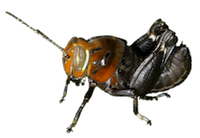
 »
»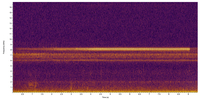
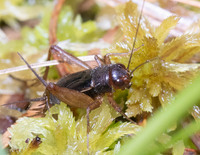
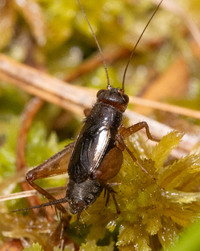
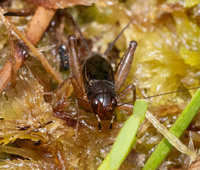

 »
»


